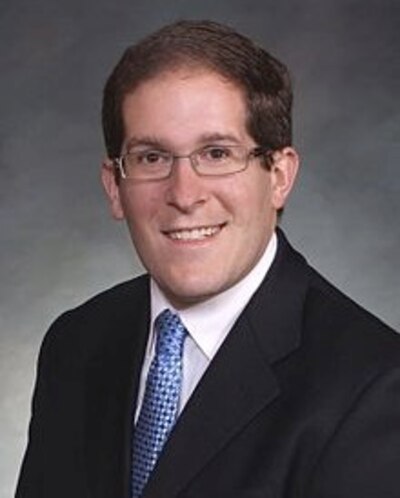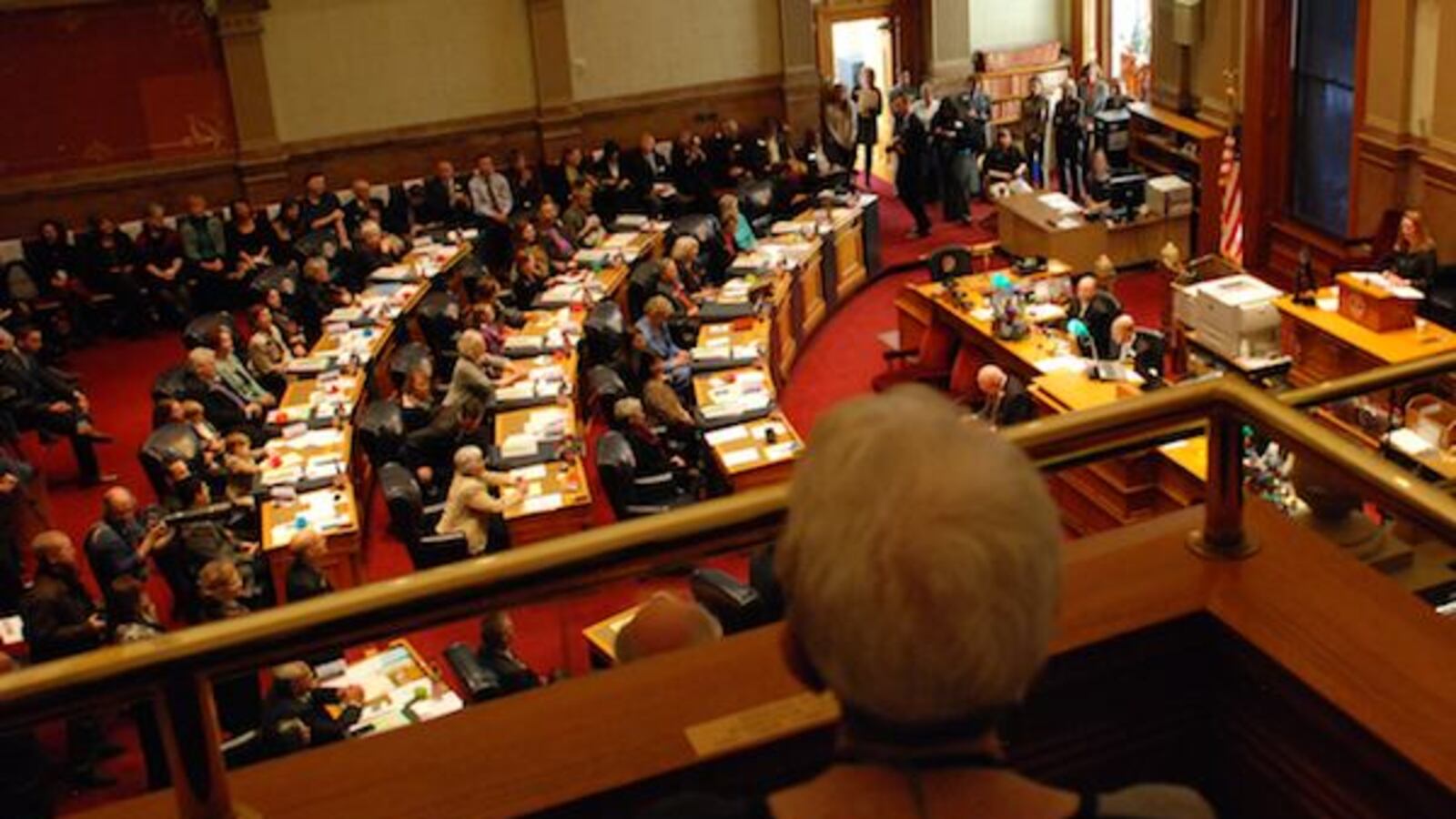Updated Jan. 8 – The 2014 Colorado legislative session opened Wednesday with the standard calls for bipartisanship and serving the public, the usual rhetorical nods to education and the introduction of the first education-related bills.
Higher education got much of the attention in opening-day speeches by House and Senate leaders, especially from Democratic Sen. Morgan Carroll of Aurora, the brand-new Senate president.
Carroll made education the first policy issue in her speech, saying, “Education is the backbone of a healthy democracy, a vibrant economy and is essential for individual liberty to pursue their dreams, their careers, their economic security and their passions. Affordable access to a college or trade school education is critical to protect our freedom to succeed.”
The president told a lengthy story about the struggles of her grandfather and her mother, Rebecca Bradley, to attend and finish college, and about her own financial challenges attending college. (Carroll and her mother practice law together.)
That led her into a recitation of stats about college costs and student debt and a plug for the College Affordability Act, one of the Democrats’ signature 2014 bills.
The measure was formally introduced a short time later as Senate Bill 14-001, with four Democratic but no Republican sponsors. The bill basically would increase state higher education spending by about $100 million in 2014-15, with more money for both state financial aid and institution operating costs. It also would a 6 percent ceiling on tuition increases next school year.
As introduced, the bill is basically identical to Gov. John Hickenlooper’s 2014-15 budget proposal. In the normal course of business that increase would have been included in the annual state budget bill. But Democratic legislative leaders decided to put the increase in a separate bill, partly for political benefit.
Over in the House, Speaker Mark Ferrandino spent less time on education in his speech but did say “strengthening our education system to prepare our students and make college more affordable” would be one of the Democratic majority’s three priorities.
“The work we do this year in the General Assembly cannot make our schools entirely whole from the hits they took during the recession. But with revenues continuing to recover, we can continue to crawl back,” the Denver Democrat said. “Our goal is to make our education system stronger, more accountable, and better for all Colorado students. And that means working together to target more resources where they’re needed most: in the classroom.”

Ferrandino specifically referenced “measures like flexible student count days, professional development for teachers and expanded programs for English language learners.” All were components of Senate Bill 13-213, the law that didn’t go into effect because voters last year defeated Amendment 66, the $1 billion tax increase that would have paid for SB 13-213.
The Republican minority leaders, Rep. Brian DelGrosso of Loveland and Sen. Bill Cadman of Colorado Springs, touched on education.
DelGrosso, saying A66 was bad policy, continued, “This session, let’s pass education reforms that will benefit all our schools and keep Colorado’s economic recovery on track.” He said Republicans would introduce bills on school district financial transparency, charter school facilities and transportation and on improving services for English language learners.
Cadman only said, “We are greatly challenged to do what’s best for our kids, and continued K-12 reform is vital. Twenty-six percent of Colorado students attend a school that is rated D or F. A quarter of our kids head to a school every day that is failing to provide them the education guaranteed to them by our constitution. This is unacceptable and inexcusable. If we don’t fix this, we are failing them.” (Cadman presumably was referring to the ratings issued by Colorado School Grades. Official state ratings don’t use A-F grades.)
All four of the speeches focused heavily on economic development, recovery from 2013’s devastating floods and wildfires and repairing some of the partisan divisions generated last session by gun control bills, energy policy and other issues.
Seven other education bills were introduced in the House and Senate Thursday. Senate Bill 14-002 would fund the Safe2Tell program and move it into the attorney general’s office. (The program provides a way for young people to anonymous report threatening or dangerous behavior by others.) Senate Bill 14-004 would allow the state’s community colleges to offer four-year degrees in applied sciences fields.
In addition to bills mentioned above, other bills of note include:
- Senate Bill 14-033 – The bill would establish a private school tuition income tax credit for private school tuition or scholarship donations, and homeschool parents also would receive a tax credit. Sponsored by 10 Senate Republicans, the idea is a hardy GOP perennial and has no chance of passage in the Democratic-controlled legislature.
- Senate Bill 14-006 – This bill would expand the current early childhood educator development scholarship program to provide stipends for students obtaining any postsecondary degree or certificate in ECE. The bill is among to first to propose funding from the State Education Fund (SEF), a piggy bank that lots of lawmakers hope to tap this year.
- House Bill 14-1048 – The measure would prohibit state colleges and universities from discriminating against student religious groups.
- House Bill 14-1039 – This bill also could tap the SEF and would direct various state agencies, including the Department of Education, to establish procedures to link student data collected by publicly funded early childhood education programs with the data collected by school districts. The measure also could draw fire from lawmakers concerned about expansion of education data gathering and about student privacy.
Learn more about the 2014 education landscape in Chalkbeat Colorado’s annual legislative preview.
A quick guide to the session
Understanding how the legislature works is essential to tracking how education bills fare in the sometimes-chaotic action. Here’s a guide.
Education coverage: Chalkbeat Colorado is the state’s only news service that covers education exclusively, and we staff the Capitol fulltime during the session. Coverage includes daily stories and roundups on our website, the exclusive Education Bill Tracker and Twitter and Facebook updates. Follow @ToddEngdahl on Twitter.
You also can stay current through our Capitol eNewsletters, which are sent every weekday evening. A week-ahead email is sent on Sunday evening. See the signup box on our homepage to subscribe.
Education decision makers: Virtually all education legislation – there usually are 60-80 or more such bills every year – has to go through the House and Senate education committees.
House Education, chaired by Dillon Democratic Rep. Millie Hamner, meets in Capitol room 0112 Mondays at 1:30 p.m. and Wednesday mornings after floor work has been completed. (13 members)
Senate Education, led by Democratic Sen. Andy Kerr of Lakewood, meets Wednesday mornings after floor adjournment and Thursdays at 1:30 p.m., generally in room 356. (7 members)
Another key panel for education is the six-member Joint Budget Committee, which prepares the annual state budget bill and other fiscal measures. It generally meets every day after floor work is finished. Because bills are not assigned to the JBC for consideration, it doesn’t take public testimony at its hearings.
Profile of the legislature: The Senate has 35 members, 18 Democrats and 17 Republicans. Senators can serve two four-year terms. The 65-member House has 37 Democrats and 28 Republicans. Representatives can serve four two-year terms. About half the Senate seats and all House seats are up for election in November.
Rhythm of the session: Because the state constitution limits the length of sessions (lawmakers must adjourn this year by May 7), a lot of work gets packed into a short period of time.
Floor sessions are held in the morning Monday through Friday, while committee work is scheduled late in the morning and in the afternoon Monday through Thursday. Friday is a getaway day early in the session. As the adjournment date approaches, long Friday floor sessions become the norm.
The pace is fairly leisurely in January (although a lot of bills the majority doesn’t support get killed) and then picks up steadily until late April, when major bills such as the state budget and annual school finance bill are considered in a rush of work that often runs into the evenings. There is a detailed schedule of when certain kinds of bills are supposed to pass, but deadline extensions are granted frequently.
How bills move: All bills are supposed to have at least one committee hearing. To become law, a bill must pass out of committee in the chamber where it was introduced and pass two floor votes. The process has to be repeated in the second chamber, with further committee work and floor votes to reconcile amendments if necessary.
Individual lawmakers can introduce up to five bills each session, but there are frequent exceptions to this rule.
Making your voice heard: Public testimony is welcome at committee hearings. Witnesses need to sign in before a meeting starts. Some committee chairs limit each witness to just a few minutes; others are more flexible.
Contacting lawmakers: Every legislator has a Capitol office for use during the session and can be reached by phone and email (directory here). Voice mails and emails generally are read first by assistants and interns. If you want to buttonhole lawmakers in the Capitol halls, they’re the ones with the black nametags. (The legislature has an elaborate system of different colored nametags for staff members, lobbyists, journalists and others.)
Follow the action: The House and Senate galleries are open to the public during floor sessions – be alert for large groups of kids filing in and out during field trips. Committee meetings also are open to observers.
If you can’t get to the Capitol, video of floor sessions is streamed online, and there are live audio feeds of all committee meetings. Both video and audio are archived, so you can catch up on past meetings. See video and audio links here.
Read the paperwork: The legislature floats on a sea of documents, virtually all of which are available online. (Many lawmakers now carry iPads instead of armloads of file folders.)
- General Assembly home page
- House bills
- House calendar
- House journals
- Senate bills
- Senate calendar
- Senate journals
(Calendars for the next day often aren’t posted until after 5 p.m.)


